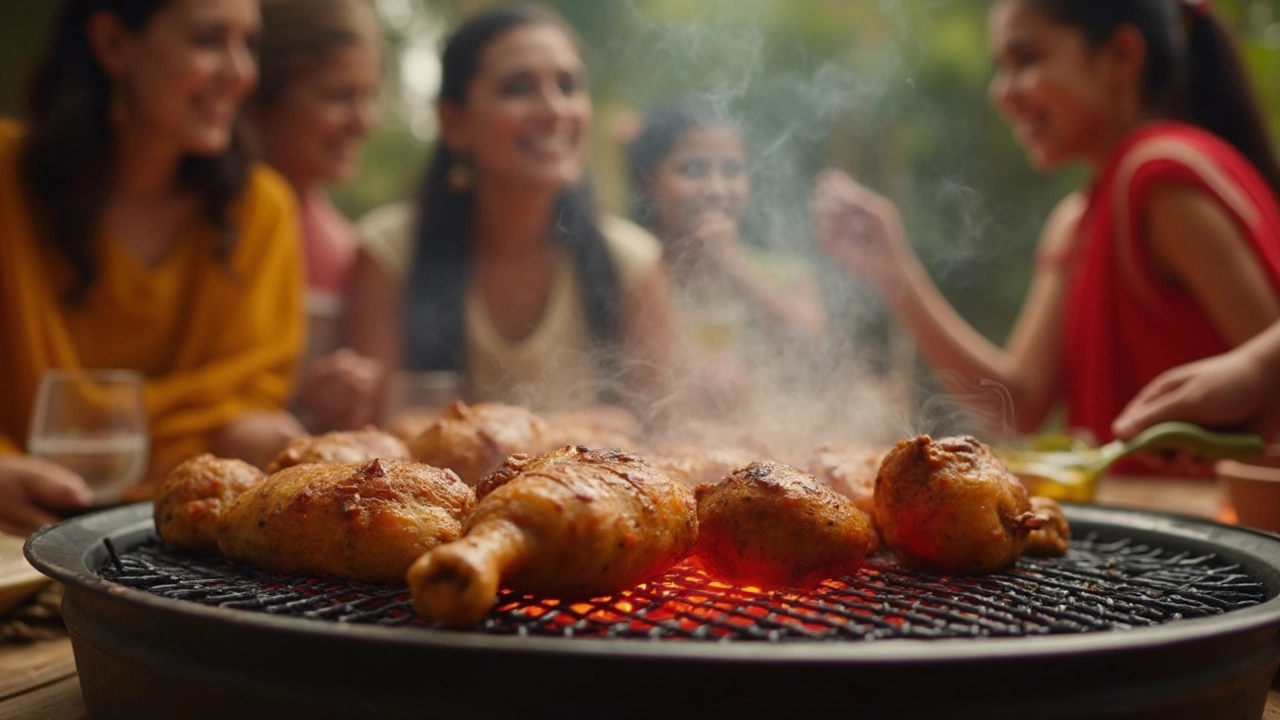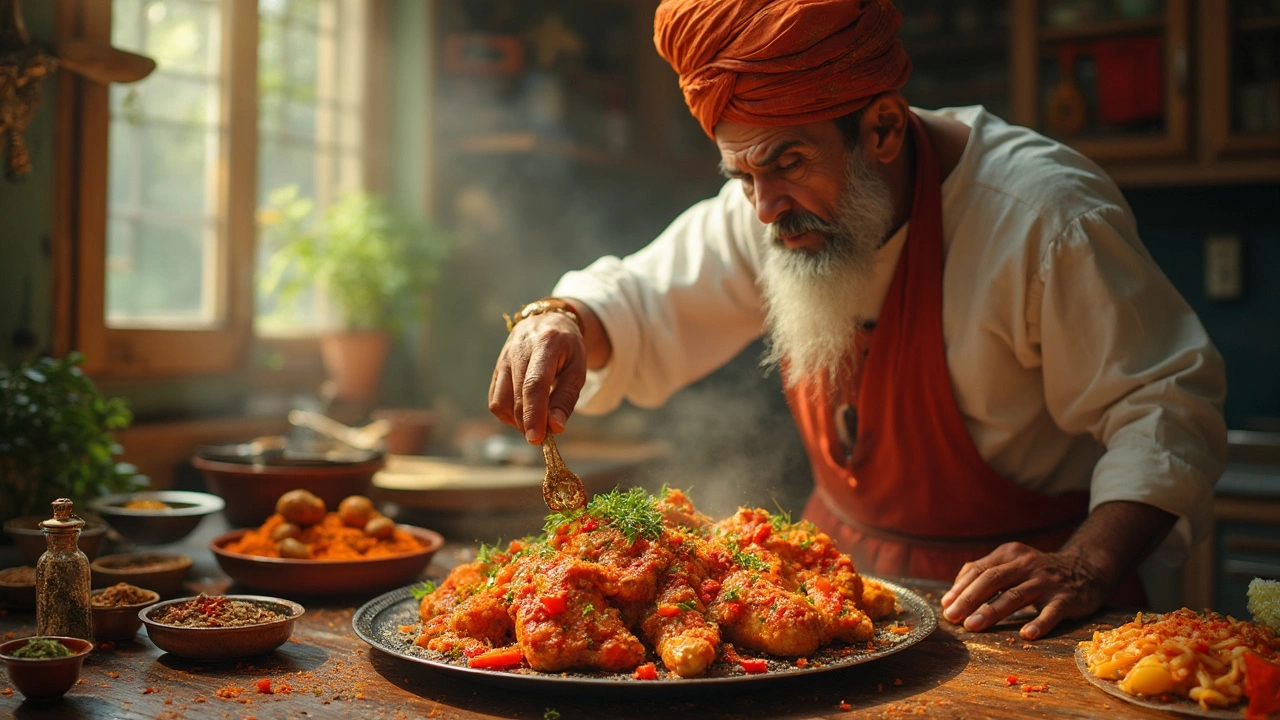Ever pulled your tandoori chicken out of the oven, only to find it swimming in a pool of liquid? It's beyond frustrating! While it's not exactly what you signed up for, worry not. This common kitchen mishap usually boils down to a few manageable causes.
First up, the texture of your chicken plays a huge role. If you're using frozen chicken, it might still hold a bit of water from thawing. This can lead to that unwelcomed pool later when cooking. Trying to make the best tandoori dish ever? Opt for fresh chicken whenever possible.
Now, marinating might seem like the least of your concerns, but it truly matters. An effective marinade not only flavors your chicken but helps retain moisture. Striking the balance here is key—too much liquid in the marinade and you're set up for sogginess.
Finally, it's all about that temperature control during cooking. Preheating your oven to the right temp ensures your chicken starts cooking immediately. Trust me, it'll thank you by not leaving a watery trail! Stay tuned as we dive deeper into each of these areas to rescue your tandoori!
- Understanding the Chicken's Texture
- Tips for Marinating Tandoori Chicken
- Cooking Techniques for Crispy Perfection
- Preventing Common Mistakes
Understanding the Chicken's Texture
Texture matters more than you might think when it comes to achieving the ideal chicken for your tandoori dish. But what’s really causing that liquid mess? Let's dig into this a bit.
Fresh vs. Frozen: The Great Debate
Hands down, the choice between fresh and frozen chicken can significantly impact your cooking outcomes. Frozen chicken, even when thoroughly thawed, can retain excess water—sort of like a sponge. As it cooks, this water releases, causing that dreaded sogginess.
For optimal results, go fresh. It's easier to manage and reduces the hassle of extra liquids messing up your cooking journey. Plus, fresh chicken just has a better texture overall, which is perfect when you're after that ultimate tandoori crispness.
Checking that Chicken Quality
Believe it or not, not all chicken is created equally. Pay attention to the quality of the chicken you're buying. An abundance of water or even injections of saline (used by some producers to add weight) can leave you with more liquid than you'd like. When shopping, look for chicken labeled as 'air-chilled'—this often translates to less moisture retention.
Trimming with Purpose
While buying the chicken is one step, how you prep it matters too. Take a few minutes to trim off excess fat and any bits that may have water-clogged tendons or skin. Getting rid of these before cooking helps keep the dish lean and less messy.
- Opt for thigh pieces if you want richer flavor and easy handling.
- Avoid cutting pieces too small, which can dry out in the oven, negating the purpose of keeping them moist.
All these tiny adjustments contribute to a better chicken texture, letting you present the most drool-worthy tandoori recipe to your friends and family.
Tips for Marinating Tandoori Chicken
The magic really happens during the marinating stage for tandoori chicken. This is where you infuse flavor and ensure that your chicken remains tender and delicious. Here's how to do it right.
Choose Your Yogurt Wisely
Use plain, unsweetened yogurt as your base. This ingredient is key for the tandoori recipe because it tenderizes the meat, thanks to its lactic acid. Opt for full-fat yogurt, as it locks in moisture better, preventing that dreaded dryness.
Spice it Up
Get bold with spices. Don't just rely on store-bought blends. Making your own spice mix ensures fresher flavors. Common spices include cumin, coriander, paprika, turmeric, and of course, garam masala. Mix well and adjust levels to suit your taste.
The Acid Touch: Lemon or Vinegar?
A splash of lemon juice or vinegar can add that zesty kick. Acid acts similarly to yogurt in breaking down proteins, meaning your chicken ends up more tender. Just don't overdo it, or it can become mushy.
Timing
Give your chicken some time to soak up all the goodness. A minimum of three hours is needed, but overnight marination is even better! Just cover it and let it chill in the fridge.
Packaging the Marinade
Ensure every piece is covered. Using a resealable plastic bag can be the easiest way to make sure your chicken stays bathed in all that savory marination. Plus, it’s easy to squish around to coat evenly.
Try these tips next time you set out on your tandoori adventure, and you'll likely notice a huge difference. It's not just about flavor, but how that chicken feels when you bite into it—juicy, tender, and packed with the spices we love.

Cooking Techniques for Crispy Perfection
Getting that tandoori chicken just right isn't just about the marinade—it’s a whole technique game during cooking too. You want that perfect balance where the outside’s all crunchy while the inside stays juicy.
Start With a Hot Oven
One of the main secrets? Preheat your oven! Seriously, don't skip this step. A high starting temperature (think around 475°F or 245°C) kickstarts the cooking, giving the skin a head start on that crispy finish.
Use a Wire Rack
Forget about slapping your chicken directly on a baking sheet. Use a wire rack instead. This helps air circulate all around, meaning no soggy bottoms. Plus, it lets any extra liquid drip off instead of soaking back in.
Mind the Time
Avoid overcooking, which dries the chicken. Check around the 25 to 30-minute mark depending on the size of your pieces. A meat thermometer can be super handy—aim for about 165°F or 75°C at the thickest part, but get it out a few degrees early as it keeps cooking while resting.
Cranking Up the Grill
If you’re feeling adventurous, pop the chicken under the broiler for the last few minutes. This is your chance to give it some extra sizzle without burning. Just keep a close eye on it!
| Cooking Method | Temperature (°F) | Time (Minutes) |
|---|---|---|
| Bake | 475 | 25-30 |
| Grill (Broil) | High | 3-5 |
Master these cooking techniques, and your tandoori chicken will not just taste amazing, but look it too. No more watery woes—just crispy, flavorful perfection!
Preventing Common Mistakes
The road to perfect tandoori chicken is paved with a few potential pitfalls. Luckily, once you spot these troublemakers, you're well on your way to a crispy, juicy meal.
Choosing the Right Chicken
It all starts with selecting the perfect piece of chicken. Buy fresh if you can; frozen chicken sometimes carries excess water which can later turn your dish soggy. If frozen is your only option, make sure it's completely thawed before cooking.
Mastering the Marinade
A good marinade is the heart of tandoori recipes. Aim for a thicker consistency that clings to the chicken. Avoid overly watery marinades which will just run off and collect at the bottom of your cooking tray. A great ratio is about 2 parts yogurt to 1 part spices.
Temperature Matters
Preheating the oven is non-negotiable. An even, consistent heat setting ensures your chicken starts cooking the moment it hits the oven. And always use a rack if possible; this allows hot air to circulate, giving it that desired golden crust.
Watch the Cooking Time
Overcooking can lead to dry chicken, but sneaking a peek too often? That lets out heat and extends cooking time. Patience is key here. Set a timer and only check when you're getting close to the finish line.
Avoid Cluttered Cooking
One last tip—don't overcrowd the pan. If pieces are jammed together, they'll steam instead of roast. Give each chicken piece its space!
By keeping an eye on these factors, you'll sidestep the common mishaps and master that perfect tandoori chicken.
